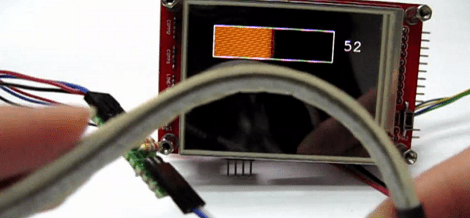When [Michelle] was making a sign language translation glove, she needed a bunch of flex sensors. These flex sensors cost about $10 a pop, meaning her budget for the project was eaten up by these bendy potentiometers. Since then, [Michelle] figured out a great way to make extremely inexpensive bend sensors using anti-static bags and masking tape, allowing her to start her project once again.
The build works by sandwiching Velostat plastic bags – the same electrically conductive bags all your components arrive in – between layers of masking tape. A jumper wires is attached to a strip of Velostat attached to a piece of masking tape. Between two of these anti-static/masking tape assemblies, another piece of Velostat is placed. After laminating all these pieces together, [Michelle] had a primitive yet very functional flexible potentiometer.
After attaching one of these flex sensors to an analog input of her dev board of choice, she had a wonderful and inexpensive flexible sensor. You can check out this sensor in action after the break.
















YouTube link for those who detest Vimeo:
http://youtu.be/WZYpGrRibKk
Youtube is godawful since they introduced HTML5 everywhere. Why would you prefer it to the smooth player of vimeo?
Fully-updated everything yields: http://i49.tinypic.com/33nat09.jpg
I never use in-browser players to watch videos.
I just download them using clive or cclive on Linux, and watch them in mplayer.
This way I never have to deal with annoying player interfaces or stupid web page designs. I can just get the content and watch it at my leisure, using a decent, dedicated, non-browser-based interface.
Nice
i like it! clean demonstration also. What constitutes the flex percentage?
I love how many wearable electronics projects repurpose packaging material such as anti static bags or foam.
Similiar for pressure instead of flex:
http://justgeek.de/simple-pressure-sensors/
(Full disclosure: link to my own blog)
Excellent!! Glad to see this documented nicely. I recall seeing it demonstrated/used for some DIY pressure sensing projects a decade or so ago… back when I was hacking the nintendo powerglove.
Thanks for the kind comments everybody! =)
I’ll be really happy to see these being made and used for mind-blowing stuff. But I’ll be just as happy if these actually helped someone out.
@NsN: Great project at your site! Would never have thought of using pressure sensors to log sleep patterns. Then again. I don’t really move in my sleep.
@raged: I’m not sure if I understood your question correctly, but I mapped the voltage i was getting to percentage so it’s easier to draw to screen.
Cheers
Michelle
Another option is to take rubber cement mixed with powdered graphite, and sandwich it between two pieces of flexible plastic cut from a soda bottle or something similar. Insert electrodes. Works great!
Very nice
@Stoutlimb – interesting tip. fyi powdered graphite is sold in hardware stores as “graphite grease”
What is the cycle count on this? The standard commercial flex sensor available from sites like sparkfun say they’re rated for >1m, but users say they have trouble getting 1000.
I need it for a pair of gloves that will be flexed many, many million times. Any ideas?
please can u tell me about velostat and from where will i get it?
Can anybody explain how the resistance is made less by bending the conductive bag material? Is the path for the current made less when bent? Thanks
@Stoutlimb – Do you, as @technodream suggests, use graphite grease from a store? Often it contains more than just graphite. Do you grind up a stick of graphite? And do you need to use rubber cement, or will other kinds of adhesive work if they are flexible?
Can you tell me at which temperature you laminated velostat? I just laminated two pieces of Velostat 4mil (0.1mm) in a sandwich of
two papers on top –
two layers of velostat –
two papers on the bottom
after the process the surface is dull and seems to be conductive only partly. I am wondering what I do wrong.